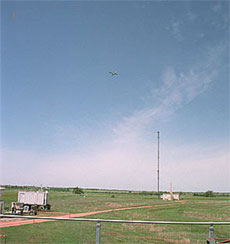
Because Earth’s atmosphere is comprised almost entirely of nitrogen and oxygen (78% and 21% by volume, respectively), the remaining 1% of the gases are referred to as “trace gases.” Trace gases include harmless inert gases, such as helium and neon, but also radiatively active gases, like methane and carbon dioxide. These latter gases, especially carbon dioxide, have been shown to enhance Earth’s natural greenhouse effect. As such, their contribution to global climate change is the focus of much research. July 2006 marked the beginning of a two-and-a-half year field campaign at the ARM Southern Great Plains (SGP) site to obtain airborne trace-gas measurements.
During the first year of the Aircraft Carbon field campaign, ARM researchers will focus on developing the capability to measure continuous carbon dioxide concentration profiles from the surface to mid-troposphere (i.e., 5-7 km). Such measurements will facilitate calibration of the Orbiting Carbon Observatory and improve computer models that simulate Earth’s carbon budget. They will also augment existing flask-based collection of trace gases (carbon monixide, methane, and stable isotopes of carbon dioxide, or 13CO2) by sampling at more heights and adding a sampler for radiocarbon (14CO2). This suite of trace gases, enhanced by the continuous carbon dioxide profiles, will provide comprehensive data for inverse methods that infer ecosystem carbon exchange and quantify anthropogenic (manmade) combustion emissions.
After the first year, researchers plan to add three other temporary measurement systems: (1) a collection system for large air volumes (mainly to capture 222Radon, a tracer for atmospheric transport), and (2) equipment for trapping of water vapor for isotopic analysis.
Additional collaborators will support developing the instrument systems, analyzing the data, and ingesting all data to the ARM Data Archive. Trace gas measurement obtained at the SGP during this campaign will provide valuable data for addressing carbon-cycle questions stressed by the U.S. Climate Change Science Program and the North American Carbon Program.
*Climate Change Science Program has been changed to Global Change Science Program @ globalchange.gov

